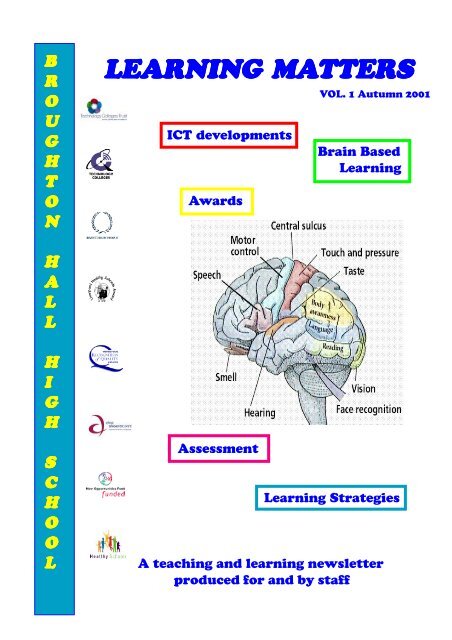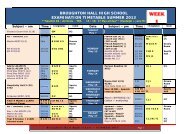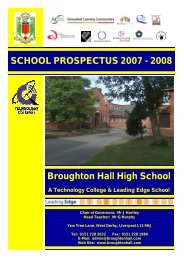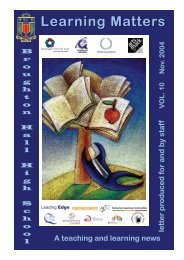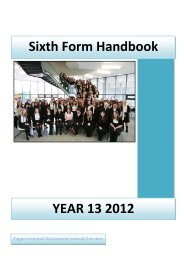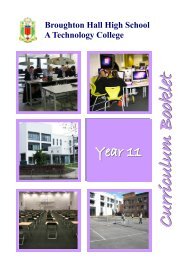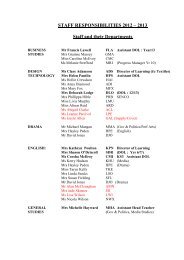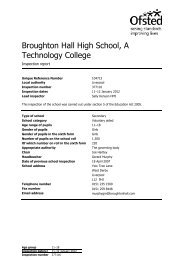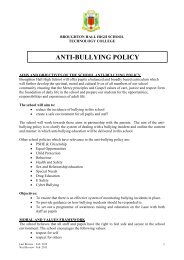Learning_Matters Volume 1 (Autumn 2001) - Broughton Hall High ...
Learning_Matters Volume 1 (Autumn 2001) - Broughton Hall High ...
Learning_Matters Volume 1 (Autumn 2001) - Broughton Hall High ...
You also want an ePaper? Increase the reach of your titles
YUMPU automatically turns print PDFs into web optimized ePapers that Google loves.
B<br />
R<br />
O<br />
U<br />
G<br />
H<br />
T<br />
O<br />
N<br />
LEARNING G MATTERS<br />
ICT developments<br />
Awards<br />
VOL. 1 <strong>Autumn</strong> <strong>2001</strong><br />
Brain Based<br />
<strong>Learning</strong><br />
H<br />
A<br />
L<br />
L<br />
H<br />
I<br />
G<br />
H<br />
S<br />
C<br />
H<br />
O<br />
O<br />
L<br />
Assessment<br />
<strong>Learning</strong> Strategies<br />
A teaching and learning newsletter<br />
produced for and by staff
LEARNING<br />
MATTERS<br />
- a teaching and learning newsletter<br />
<strong>Volume</strong> 1 – <strong>Autumn</strong> <strong>2001</strong><br />
Introduction from the Headteacher<br />
Welcome to what I hope will become a termly magazine aimed at sharing and developing<br />
the many examples of good practice in our school. It will also provide an<br />
opportunity to update colleagues on forthcoming developments as we continue to<br />
work towards further improving the quality of teaching and learning at <strong>Broughton</strong><br />
<strong>Hall</strong>.<br />
I’d like to take this opportunity to thank all the staff who have made contributions to<br />
the first edition of ‘<strong>Learning</strong> <strong>Matters</strong>’ with particular thanks to those who have worked<br />
to transform an idea into reality by assisting in the practical production of this edition<br />
- notably Danny Blunsum, Kim O’Hare, Steve Lyon and Margaret Grant.<br />
I hope that you find the articles useful and that many more of you will add your own<br />
contributions to forthcoming editions.<br />
Gerard Murphy<br />
October <strong>2001</strong>
Introduction from the Editor<br />
First, a “thank you” to everyone on the staff who has helped this particular ‘new girl’<br />
to settle in during the last few weeks. I can tell you, it really makes a difference and<br />
has made my learning curve a little less steep!<br />
You may well have stumbled across me when trying to make a dash for the car park;<br />
if not, the mugshot above may help you track me down.<br />
Amongst other things, I have an interest in and responsibility for the ongoing development<br />
of learning strategies at <strong>Broughton</strong>.<br />
The more one reads about, talks about or watches others practising the art of teaching,<br />
the more fascinating this job becomes. But how to share it? Did you know that<br />
80% of knowledge about the function of the brain in learning has emerged in the last<br />
15 years? You did? Well, you never told me... So basically that’s what this newsletter<br />
is going to be all about: in no particular order and with no special brief other than<br />
information - a place to circulate ideas.<br />
So let’s get started and where better to start than with a bit of professional aggrandisement:<br />
“Teachers affect eternity; no one knows where their influence stops” (Anon)<br />
Margaret Grant
Book of the Term<br />
Review - G Murphy<br />
The <strong>Learning</strong> Revolution<br />
by Gordon Dryden and Dr Jeannette Vos<br />
As one of my Performance Management objectives<br />
is to improve my understanding of Accelerated<br />
<strong>Learning</strong> Theories I recently attended a one day<br />
seminar in London by Gordon Dryden and Jeannette<br />
Vos, authors of ‘The <strong>Learning</strong> Revolution.<br />
A new updated version of ‘The <strong>Learning</strong> Revolution’ has just been<br />
published in Britain. It has proved to be one of the largest and fastest<br />
selling non-fiction books of all time, selling well over 10 million copies<br />
around the world.<br />
In a very readable format the books draws together the latest research on brain based and accelerated<br />
learning techniques and sets them in the context of our rapidly changing world due to the instant communications<br />
revolution and also offers very practical and common sense approaches to implementing new<br />
teaching and learning strategies.<br />
Every second page is a ‘poster page’, which highlights key points providing an overview of the book,<br />
which means that much of the information can be skim read in 30 minutes.<br />
Gordon Dryden is a New Zealander with a background in business; Jeannette Vos is a Dutch Canadian<br />
who lectures in the United States on learning development. Their central argument is that a <strong>Learning</strong><br />
Revolution needs to take place to meet the demands of a rapidly changing world where people live longer,<br />
where unskilled workers are no longer required and where education is vital to maintain a cohesive society.<br />
They say that the learning revolution is based on modern research into how the brain works linked to<br />
harnessing the power of instantly available information and knowledge from anywhere in the world.<br />
To indicate the pace of change they note that:<br />
‣ Your cellular phone has more computer power than the combined computers of the Second World<br />
War.<br />
‣ By 1988 a single fibre optic ‘cable’ could carry 3,000 electronic messages. By 2000 this was 10<br />
million.<br />
‣ In 1993 the first Internet browser was developed – there are now over 500 million Internet users.
‣ Ireland, which 25 years ago was a largely agricultural economy, is now the world’s largest exporter<br />
of software.<br />
‣ Only 3% of homes in China have phones but shortly 65% will have TV which gives Internet access<br />
and voice activated software.<br />
‣ 90% of new jobs are in companies with fewer than 50 people.<br />
Dryden and Vos note that the pace of change in the world has not been matched by fundamental change in<br />
education – where we still work on a Victorian model.<br />
In order for education to move forward with the pace of social and technological change Dryden and Vos<br />
argue that increased awareness of how the brain works and the application of brain based learning is vital.<br />
Some facts:<br />
‣ You have had 100 billion active brain cells since birth<br />
‣ There were 200 million Internet ‘hits’ on the 1997 Mars probe over 3 days – Your brain can make<br />
15 times as many new connections in a second.<br />
Dryden and Vos outline the links between research into the brain and its implications for learning. They<br />
believe that one of the key functions of a school is to teach children how to learn and to develop their<br />
thinking skills. They outline many practical approaches to introducing new learning techniques and quote<br />
many examples from around the world to show how these techniques have been successful.<br />
The seminar provided by the two authors was thought provoking, stimulating and received a very positive<br />
response from the audience. The book is easy to read, fascinating in its exploration both of technological<br />
change and the challenges facing education today.<br />
I would be prepared to provide a copy of the book and CD Rom for each member of staff who<br />
expresses an interest. It is an important work and potentially a very strong influence for change.<br />
“Well, why not take Mr Murphy up on the offer - headteachers don’t often give<br />
things away for free! Honestly though, it really is a book well worth reading... I<br />
couldn’t put it down this summer...it was just so good. Sad? Possibly, but with a<br />
record 10 million plus sales so far, there just might be something in it.”<br />
Margaret Grant
WHY DOES<br />
LEARNING<br />
MATTER?<br />
With so much going on in education at the moment this would seem a perfectly<br />
natural question. There is the new framework at Key stage Three, Post – 16 is<br />
changing constantly, and performance management is still in its infancy. That is<br />
before we begin to consider use of pupil data and target setting. Given all this and the<br />
fact that we had such a significant rise in our GCSE results this year, why do we need<br />
to change the way we do things in the classroom as well? Why does learning matter?<br />
Perhaps the key to answering this question is to look beyond our own classroom and<br />
consider the issue from a more global perspective.<br />
THE LEARNING REVOLUTION<br />
• We now know how to store all humanities’ combined knowledge and wisdom, and make it almost<br />
instantly available to anyone anywhere.<br />
• We need a learning revolution to match the revolution in instant communication, which in itself is<br />
generating a new economy, a new politics and a new society.<br />
• As life expectancy increases but work life doesn’t lifelong continual learning will be a key fact of<br />
life for everyone.<br />
We need to make sure we equip our pupils and ourselves to be a part of this new society.<br />
THE NEW FACE OF EDUCATION<br />
• School systems around the world are wasting billions of pounds on IT. They are trying to graft the<br />
tools of the 21 st Century on to an educational model designed to service a 19 th Century industrial<br />
economy.<br />
• At last we are beginning to use the most brilliant human resource of all – the brain!<br />
• The virtual classroom is already a reality. In Pittsburgh, Pennsylvania, The Carnegie Mellon University<br />
is America’s best online university.<br />
• Large corporations such as Anderson Consulting, Microsoft and the Disney Corporation are developing<br />
their own universities.<br />
We can no longer assume that schools will be the automatic first choice for education. We need<br />
to make sure we can compete in the ‘education market’.
LEARNACY (learning about learning)<br />
• We now know that everyone of us has a unique learning and thinking style. Yet many schools and<br />
universities still “teach” as if every student learns in the same way.<br />
• In many of the world’s most commercially successful companies the educational need is for thinking<br />
and conceptual skills and openness to change and opportunity. How much of this is taught in<br />
schools?<br />
• We now understand that intelligence is not fixed.<br />
If intelligence is not fixed then neither should teaching or learning. We need to use what we<br />
have learned about learning.<br />
GLOBAL PERSPECTIVE<br />
• With the development of the Internet we are moving to a world without economic borders. The<br />
job market will effectively become worldwide.<br />
• In Singapore they have replaced a knowledge-based curriculum with a skills curriculum. Look at<br />
their position economically and globally.<br />
• At Beijing’s 21 st Century Experimental school they have combined traditional values with interactive<br />
technology. China has increased its economy more than 400% in the past 20 years thus<br />
releasing more people from poverty than any other society in history.<br />
• We already use the phrases, ‘global citizen’ and ‘global qualification’.<br />
• The new interconnected globalised society needs a new model for learning.<br />
One function of education is to prepare students for the real world. If the world is changing on a<br />
global scale and at such a rate then education must change too.<br />
THE WORKING REVOLUTION<br />
• It is estimated that by the time our present GCSE students enter the workforce they will have at<br />
least 12 changes of job in their working life.<br />
• Many of the jobs that our pupils will end up doing don’t even exist at present.<br />
• Over 50% of investment in new business is in ideas.<br />
• The ability to think and create has become a financial commodity in itself.<br />
If we don’t know what the jobs are how can we prepare pupils to do them? We have to teach<br />
them the skills to be able to adapt.<br />
If we don’t embrace the learning revolution and accept that learning matters an elite 20% could end up<br />
with 60% of each nation’s income, the poorest 20% with only 2%. This would guarantee poverty, school<br />
failure, crime, despair, possibly even violence and social eruption. Haven’t we moved on from this?<br />
We might also be excluding our pupils from being part of a world that will be like none that has ever been<br />
before. Is that why we became teachers? For the first time in history, almost anything is possible, isn’t that<br />
why learning matters?<br />
Linda Brennan
The Mozart Effect<br />
In 1957 French physician Dr Alfred Tomatis started to research the link between<br />
learning and the sonic environment. By 1965 he had concluded that<br />
Mozart’s music can stimulate the brain, relax the body and create a sense of<br />
order.<br />
Don Campbell, inspired by Tomatis’s findings, has compiled a series of CDs<br />
called “Music for the Mozart Effect”. Each CD is aimed at stimulating the<br />
mind in a different way.<br />
<strong>Volume</strong> I<br />
<strong>Volume</strong> II<br />
<strong>Volume</strong> III<br />
<strong>Volume</strong> IV<br />
<strong>Volume</strong> V<br />
Music for Intelligence and <strong>Learning</strong><br />
Music for Rest and Relaxation<br />
Music for Creativity and Imagination<br />
Music for Projects and Study<br />
Music for Deep Rest and Rejuvenation<br />
I bought volume IV at the beginning of term and have been playing it in class<br />
as background music during the Mental and Oral Starter and while students<br />
are doing individual work.<br />
Don Campbell claims that the music, with its complex structures and patterns,<br />
can enhance mathematical thinking skills. It is too soon to judge<br />
whether his claims are correct but the music certainly has a calming effect.<br />
Try it!<br />
Jacinta McGowan
Something to think about...<br />
ON REMEMBERING<br />
Something from “Closing the <strong>Learning</strong> Gap” by Mike Hughes, a book I would recommend.<br />
The human brain is not designed for remembering large amounts of information (content) and yet this is<br />
precisely what children are required to do during the majority of lessons!<br />
<strong>Learning</strong> content in this way often involves repetition and learning by rote: for the brain this is both<br />
unnatural and strictly limited and, without regular rehearsal, the information will only be remembered for a<br />
short period. <strong>Learning</strong> in this way is also heavily dependent upon the motivation of the individual student<br />
and this, as any teacher knows, is highly variable.<br />
What the brain does remember well, however, is context. This is the reason why students remember well<br />
how a waterfall is formed once they have stood in the cold and wet sketching one on a geography field trip.<br />
It is also why the entire class can recall what a Victorian classroom looks life after sitting in one, dressed in<br />
Victorian clothes, during a visit to a museum.<br />
The brain remembers context quite naturally and has an unlimited capacity for memories such as these.<br />
The brain is also proficient at remembering anything that is emotional, unusual, exaggerated or dramatic.<br />
Research tells us that many different areas of the brain are used for the purpose of remembering, and that<br />
using these so called ‘multiple memory systems’ is the most powerful way of ensuring that something is<br />
remembered. Put simply, this means that the more ways that the brain receives information, the more ways<br />
in which it is stored and the more likely it is to be recalled.<br />
ABOUT PRAISE AND SELF-ESTEEM<br />
• Jack Canfield, an American researcher into self-esteem, observed 100 children at home and<br />
school. On average, the children received 460 negative or critical comments and 75 positive<br />
or supportive ones every day.<br />
• Research into Transactional Analysis techniques has shown that to influence changes in behaviour<br />
four positive or supportive comments rather than one negative has a marked and<br />
powerful impact.<br />
• A survey of 50 Junior Schools in London by the Institute of Education noted that teachers<br />
spent less than one per cent of their time giving praise.<br />
Margaret Grant
SuccessMaker - A Brief Guide<br />
SuccessMaker is an Integrated <strong>Learning</strong> System (ILS). The purpose of an ILS is to deliver a programme<br />
of instruction tailored to the needs of the individual user. It then records and assesses progress through the<br />
programme and reports on that progress.<br />
SuccessMaker delivers all the following benefits<br />
• Interpretation of pupil response based on the current task<br />
• Updating pupil records based on individual responses<br />
• Choice of pathways through the curriculum content<br />
• Delivery of the appropriate sequence of learning modules<br />
• Provision of feedback to the pupils and teachers<br />
SuccessMaker offers each pupil a private learning environment away from the distractions of others. It<br />
provides each student with uniquely individualised literacy and numeracy courseware and immediate, positive<br />
reinforcement. This leads to increased concentration, motivation and time on task.<br />
Teacher Benefits<br />
• Delivery – SuccessMaker provides teachers with a wealth of material that is automatically<br />
delivered at a level appropriate to each students needs.<br />
• Diagnostics – SuccessMaker’s diagnostics capabilities allow teachers to pin-point problem<br />
areas.<br />
• Reports – over 80 reports provide detailed information on pupil progress.<br />
How is SuccessMaker Used?<br />
1. Strands-based Courses<br />
• Short focused bursts of practice, 10 to 15 per course<br />
• Repeated use, 3 to 5 times per course per week if possible<br />
• Systematic development, focusing on steady but determined steps forward<br />
2. Lesson-based Courses<br />
• Can be used more flexibly<br />
• Integrated into schemes of work<br />
• Used with individuals, pairs or classes
Enrolling Students and Automatic Progression<br />
Once students are enrolled at a particular level, for many courses SuccessMaker then performs the Initial<br />
Placement Motion (IMP), whereby pupils are presented with a number of questions and their responses<br />
are analysed.<br />
From this analysis a starting level is decided upon for each pupil. Adjustments are then continually made by<br />
SuccessMaker to the level of work presented throughout a pupils’ time on the system.<br />
A students’ pathway through SuccessMaker’s courseware is determined by the percentage of correct or<br />
incorrect answers and also by their pattern of response.<br />
If a student encounters a problem in a particular area, the system will work through a number of prerequisite<br />
skills before re-presenting the problem area. In the same way, a student who is performing well<br />
will be moved onwards to more difficult tasks. Thus ensuring that each student is stretched to their full<br />
potential.<br />
At all stages in this process the teacher is kept aware of each students strengths and weaknesses via<br />
reports that the management system generates.<br />
SuccessMaker Strands-Based Courses<br />
Maths Concepts and Skills (MCS)<br />
• Maths ability ages 5 – 14<br />
• Numeracy development and practice<br />
• Can produce differentiated worksheets<br />
• Audio support at earlier stages<br />
The MCS courses is the key maths foundation courses on SuccessMaker, made up of over 300 hours of<br />
instruction with over 30000 activities. The course both covers computation and application strands and is<br />
designed to improve students higher order thinking and problem solving skills.<br />
Computation<br />
Addition<br />
Subtraction<br />
Multiplication<br />
Division<br />
Fractions<br />
Decimals<br />
Equations<br />
Speed Games<br />
(mental arithmetic)<br />
Application<br />
Number Concepts<br />
Geometry<br />
Measurement<br />
Problem Solving<br />
Science Applications<br />
Applications<br />
Word Problems<br />
Probability and Statistics
Initial Reading (IR)<br />
Initial Reading is designed to supplement the classroom reading that pupils will do on regular basis. Vocabulary<br />
development is a key area and there are 1768 high frequency words in this course which are used<br />
to build word meaning, word patterns and sight word development. Initial Reading is fully audio supported<br />
and the presentation consists of colourful animations and engaging activities.<br />
Six strands within Initial Reading cover:<br />
1. Letter Identification<br />
2. Patterns<br />
3. Sight Words<br />
4. Word Comprehension<br />
5. Sentence Comprehension<br />
6. Passage Comprehension<br />
Reader’s Workshop (RW) Age 8-13<br />
Designed to develop reading and critical thinking skills, Reader’s Workshop combines practice in specific<br />
reading areas with comprehension and theme based lessons and contains over 12000 activities in all.<br />
The following strands are assessed<br />
Thematic Lessons (TL)<br />
Passage Comprehension (PC)<br />
Interpretive Comprehension (IC)<br />
Literal Comprehension (LC)<br />
Word Meaning (WM)<br />
Word Analysis (WA)<br />
Reference Skills (RS)<br />
During each session of the course the student will take a number of exercises from across a range of skill<br />
areas. These sessions will be individual to each student based on SuccessMaker’s analysis of their<br />
strengths and weaknesses. Therefore a pupil with good word analysis skills will be progressed at a higher<br />
rate in that area than they would in a personal weak area. Worksheets are provided for either classroom or<br />
homework use and can be assigned to a whole class on a particular topic or to individual students based<br />
upon their work on the system.
Non Strands-Based Courses<br />
Numeracy<br />
Maths Investigations – Students are encouraged to apply their mathematical skills to a ‘real life’<br />
activity. Each of the 24 investigations is a learning adventure, with graphics activities that challenge<br />
and motivate the student.<br />
Maths Processor – This provides an environment for pupils’ teachers to use the tools available in<br />
Maths Investigations but to do so independently in an interactive manner.<br />
Algebra Topics – This gives students instruction, practice, application, assessment and review in<br />
algebra. The course contains over 1500 exercises.<br />
Literacy<br />
Reading Adventures – contains over 100 award-winning, multicultural extracts and is presented<br />
using a mixture of audio, text, music, graphics and animation.<br />
Reading Investigations- this course is designed to improve students’ comprehension and thinking<br />
abilities. At the core of Reading Investigations are 182 guided reading lessons based on extracts<br />
from literature including novels, poetry and non-fiction.<br />
MikeTollitt
BRAIN GYM<br />
Ever noticed your class dropping off to sleep after 20 minutes or maybe climbing up the walls?? This is<br />
because the brain can only concentrate for up to 20 minutes at a time so try some BRAIN GYM.<br />
Helps pupils to reach their full potential<br />
Brain Gym is a series of quick, fun and effective activities designed to enhance performance in all areas by<br />
assisting whole brain integration.<br />
It is a proven system of smart exercises that integrate left and right brain functions for automatic improvements<br />
in concentration, reading skills, mental energy and ease of writing.<br />
Brain Gym was initially developed to help children with learning difficulties and learning “blocks”. Brain<br />
Gym movements can have a profound effect, enabling new learning pathways to develop in the brain.<br />
They are now being used in schools, to assist all students to develop their full, often hidden, potential.<br />
Brain Gym needs no extra resources and can be used during normal teaching in the classroom or in one to<br />
one teaching. Here are some popular movements you can use in class......<br />
Neck Rolls - to relax neck and shoulders<br />
Breathe deeply, relax your shoulders and drop your head forward. Allow your head to roll slowly from<br />
side to side as you breathe out any tightness. Your chin draws a smooth curve across your chest as your<br />
neck relaxes.<br />
Lazy 8’s - Midline Movement - aids writing, reading and all types of study<br />
Draw the number 8 three times in the air with each hand, then three times with both hands together.<br />
Finish these exercises by standing very still with legs and arms crossed and taking deep breaths in to calm<br />
down. This oxygenates the brain and the students sit down relaxed and ready to learn!!<br />
INTERESTING FACT<br />
Recent research shows that children who didn’t crawl as babies (a very cross lateral exercise)<br />
find spelling very difficult because their brain missed out on this crucial primer.<br />
Research in primary schools with dyslexic children shows that using brain gym is making a<br />
marked difference to their spellings!!<br />
Interested? Give it a go, borrow the book form the ‘<strong>Learning</strong> <strong>Matters</strong>’ Library located in the<br />
Staff Quiet Room or apply for one of the following courses...
TRY THIS....TRY THIS....TRY THIS....TRY THIS....TRY THIS.....TRY THIS.....TRY THIS.....<br />
Grow your brain<br />
Eat something you have never eaten, talk to someone you have never spoken to, sit in a different<br />
chair in the staffroom, watch something on television you have never watched, do something you’ve<br />
never done before...<br />
Creating new connections is the key to staying young, fit, healthy and mentally alert. The best way<br />
to do this is not to become routinised and set in our ways. In fact, when we do box ourselves into a<br />
narrow focus, connections in the brain start to sever. The less we do the less we do ... so do<br />
something that scares you every day!!<br />
Review Strategies<br />
At the end of every lesson, focus in silence for a minute on what is the most important<br />
thing you have learnt in this hour. Bring that thought to the next lesson as a starting point.<br />
ADVERT!<br />
Brain Gym - Want to Learn More?<br />
Funding is available for the following courses. Please see Margaret Grant if you’re interested in further<br />
details.<br />
Introduction to Brain Gym in the classroom Wed. 12 November <strong>2001</strong><br />
Thur. 31 January 2002<br />
A one-day workshop to the uses of Brain Gym, providing useful skills to teachers and learning mentors. the movements<br />
can be used on a whole class or one to one basis. Participants will learn Brain Gym movements and how Brain Gym can<br />
be used as a tune up before lessons, or by using specific movements for children with specific difficulties. As these<br />
exercises work directly on neurological function rather than purely on the symptoms, the effects of these seemingly<br />
simple exercises can be profound.<br />
Brain Gym and Accelerated <strong>Learning</strong> Techniques for Teachers Wed. 5 December <strong>2001</strong><br />
Tue. 26 February 2002<br />
This is a new one-day workshop featuring the latest thinking and skills that can be used in the classroom to enhance the<br />
ability of pupils to absorb and retain information. This workshop can be modified for teachers’ needs, topics can include<br />
Brain Gym, brain dominance and its affect on learning, the use of music (the Mozart effect), neurological considerations,<br />
the 7 intelligences, and language.<br />
Brain Gym (4 day workshop) Sat. & Sun. 10-11 November and 8-9 December <strong>2001</strong><br />
Fri. & Sat. 8-9 February and 8-9 March 2002<br />
This course is certified by the Educational Kinesiology (UK) Foundation, the only body authorised to run Brain Gym<br />
courses in the UK.<br />
It is a comprehensive introduction to the use of Brain Gym and the first step on the route to becoming a Brain Gym<br />
Consultant or Instructor. The course covers all aspects of Brain Gym and includes considerable background information.<br />
At the end of the course you will be able to:-<br />
♦ Use the most appropriate of the 25 Brain Gym exercises<br />
♦ Understand the ‘Action balance’ process<br />
♦ Help children or anyone to overcome learning blocks<br />
♦ Assist others with reading problems such as Dyslexia, Dyspraxia, etc.<br />
The fee includes all documentation and course manuals and registration to the British Educational Kinesiology Foundation.<br />
N.B. Leave of absence will need to have been agreed by Mike Mangan.
Preferred <strong>Learning</strong> Styles<br />
Providing appropriate tasks which raise attainment by stimulating all pupils in a class is often challenging.<br />
Especially when you have not taught the individuals before and all you have to guide you is their examination<br />
result from the previous academic year. This practical use of pupil assessment data interested me<br />
immediately as it offers evidence of the pupils’ cognitive abilities as well as logical suggestions for the sorts<br />
of learning activities to which they are best suited. I feel that this, together with some strategies which<br />
address areas of weakness for groups of pupils, is an excellent starting point for delivering a scheme of<br />
work in a way which allows pupils to access the necessary concepts, ultimately raising attainment within<br />
the subject and across the whole curriculum.<br />
Verbal<br />
I began by selecting the CAT scores for the Year 7<br />
A B pupils I teach. The scores needed for this exercise are<br />
the non-verbal SAS and the verbal SAS. By plotting<br />
one value against the other, I was able to produce a<br />
scatter graph of my pupils’ scores. By then inserting a<br />
C D line to mark the recognised mean score of 100 on each<br />
axis, I was able to divide the graph into four quadrants<br />
which represent four different cognitive abilities and<br />
therefore four different preferred learning modes.<br />
Non-verbal<br />
Those pupils whose scores place them in Quadrant A have above average verbal capabilities but below<br />
average conceptual reasoning. These pupils can be described as Auditory/Text Learners. The sorts of<br />
activities they will enjoy and benefit from the most are reading from text books and magazines, writing and<br />
synthesising text and discussion work either as pairs, groups or the whole class. They will often be active<br />
talkers, wanting to discuss the material as you mention it. They will generally enjoy working with text<br />
based materials but will have difficulty with diagrams and charts. The thinking skills of these pupils need to<br />
be developed and the use of key words will help them develop their ideas and aid their revision. Limericks,<br />
lyrics and mnemonics will act as memory joggers and are often enjoyable for auditory/text learners.<br />
Quadrant B represents the pupils whose scores suggest they have above average verbal and conceptual<br />
abilities. With strong verbal skills and a clear understanding of the necessary concepts, they will quickly<br />
grasp ideas as they are introduced. They will learn through almost any style but prefer activities which<br />
include writing and comprehension activities, graphics and CD-Rom, summarising texts and text books<br />
with diagrams and photographs. These learners enjoy thinking work and respond well to writing about<br />
their work. The use of sequencing and storyboarding will help to develop the revision techniques of<br />
verbal/visual learners and they will also respond to limericks and mnemonics when used as memory joggers.
Visual learners is the term we use to describe those pupils with scores placing them into Quadrant C. They<br />
have below average verbal and conceptual abilities so will have difficulty with the written word and lack a<br />
thorough understanding of the organisation and convention of writing. The learning styles that these pupils<br />
enjoy include drawings and storyboarding, writing frames, videos and CD-Rom and recording using flowcharts,<br />
mind maps and concept maps. They need to have demonstrations or diagrams to cue their thinking<br />
and put them in the right direction for recalling an idea.<br />
Finally, we have those pupils whose verbal abilities are below average but whose conceptual reasoning is<br />
above average. This places them in Quadrant D and we describe them as kinaesthetic learners. They<br />
learn best through movement and simulations so prefer activities which involve discussion more than writing,<br />
physical actions to describe events, games and labelling diagrams with key words and phrases. They<br />
need to record quickly as soon as observed and need writing frames to support written activities.<br />
All of the Year 7 pupils I teach currently are placed in Quadrants C and D, so the activities I have used<br />
extensively this year have been simulations and modelling, writing frameworkds, close procedures, videos<br />
and CD-Rom and games and quizzes. The pupils seem to enjoy the lessons and often comment positively<br />
or smile as activities are introduced. Overall, my feeling is that they are progressing well and I am pleased<br />
with the marks achieved in their end of year exams.<br />
I feel it important to stress that this interpretation of data should always be used positively and in conjunction<br />
with other evidence which presents itself, not only in the form of text results and written work, but also<br />
in the ways in which pupils respond and react in the classroom. Using data in this way can help with setting<br />
classes and also in selecting appropriate activities but should most certainly not be used to “write off”<br />
children as not having the ability to achieve. Rather than focussing our energies on worrying about their<br />
weaknesses, we should take time to select activities which allow them to use their strengths and achieve<br />
success. Pupils can, and often do, surprise us.<br />
Jane Christian
<strong>Learning</strong> things!<br />
Education Coaching Diploma<br />
This course is offered free of charge by Newcastle College. It looks at the barriers to learning that may<br />
exist in the children that we teach and gives some commonsense, practical advice about overcoming those<br />
barriers.<br />
The course is funded by the Further Education Funding Council and is accredited by NCFE. There are<br />
six modules in the course:<br />
· Goal setting<br />
· The power of beliefs<br />
· Techniques for change<br />
· Removing inner barriers to performance part 1<br />
· Removing inner barriers to performance part 2<br />
· Removing outer barriers to performance<br />
Assessment comes in the form of unit tests, which you mail to the college at a variety of times during the<br />
year: feedback is prompt and useful.<br />
In a nutshell the course uses motivational techniques to alter the ways that children learn, looking at their<br />
ability to cope with situations in life that could have an effect on their learning. The course blurb suggests<br />
about 120 hours of study, when you consider that some of that time is used to read a biography of your<br />
choice you can see that you can get away with a lot less. Some tasks need to be carried out with a class<br />
of pupils ranging from simple things like goal setting to more complex tasks such as keeping a record of<br />
time when others have a negative effect on them.<br />
The course is interesting and not too difficult; I’ve got the material in school if anybody is interested in<br />
having a look.<br />
Mike Reid
NEEDED URGENTLY<br />
Ideas, articles and suggestions for next<br />
term’s newsletter would be gratefully<br />
received.<br />
All items to Margaret Grant by<br />
3 December <strong>2001</strong>.<br />
Go on, don’t be shy!


